Posts Tagged: Fusarium
Comparison of Triform 80 and a Novel Fumigant in Fusarium Infested Soil
Introduction: With the discontinuation of methyl bromide as a possibility for pre-plant soil fumigation, we at UCCE have been very active in looking for viable alternatives. One alternative, identified by the test name TRX58, having a fairly high vapor pressure and already having certain uses in agriculture, was a good one to try.
Materials and Methods: Work was done in a field known to experience pressure from the plant pathogen Fusarium oxysporum f. sp. fragariae . Application of the test material TRX58 (550 lb per acre) and the grower check of Triform 80 (34 gal per acre) was done on October 5, 2015, shanked in followed by tarping with totally impermeable film (TIF). So as to obtain adequate fumigation and coverage, both the materials were applied in blocks 22 feet wide and 200 feet long with each block replicated twice. Two strips of 11 feet wide were placed between the fumigated plots, designated as untreated checks and not treated.
Planting of the strawberry varieties Cabrillo, Albion, Sweet Ann, San Andreas and Monterey was done on Nov 17. Plots were maintained as any other on the farm with adequate fertility and irrigation. Pick stations of 20 plants per variety x 4 replicates and commencing in April fruit harvest in all plots was done once a week and fruit weighed.
Statistical analysis is as below, and broken up into two halves (April + May) and then also given as a total.
Discussion: Triform 80 is indisputably the better treatment, but it is also indisputable that TRX58 is better than doing nothing, which as one can see from the photos is not wise in this sort of situation. It is also notable that variety such as San Andreas which is known to be "resistant" (actually tolerant is the better word) to Fusarium still loses a little bit more than half of its yield in unfumigated soil. There is a strong case being made here for treatment of soil to maintain good strawberry yields.
A deep bow of gratitude to Miguel Ramos for letting me do this work in his field, to Mark Curtice from Lassen Canyon Nurseries who gave us the plants, and then to Trical who did the fumigation.
People should realize that without the efforts of all these people working together, we would be doing very little novel fumigation research right now.
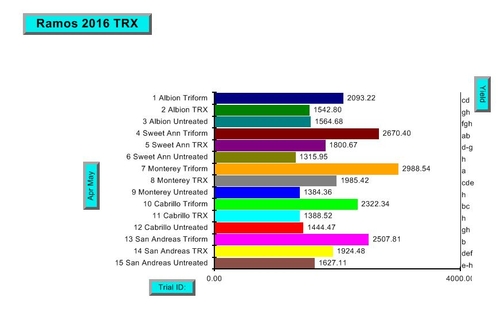
Statistical summary in 10 lb boxes per acre for first two months of study. Click on image to embiggen.
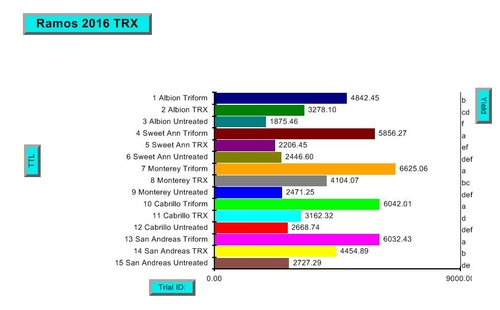
Statistical summary in 10 lb boxes per acre for total harvest. Click on image to embiggen.
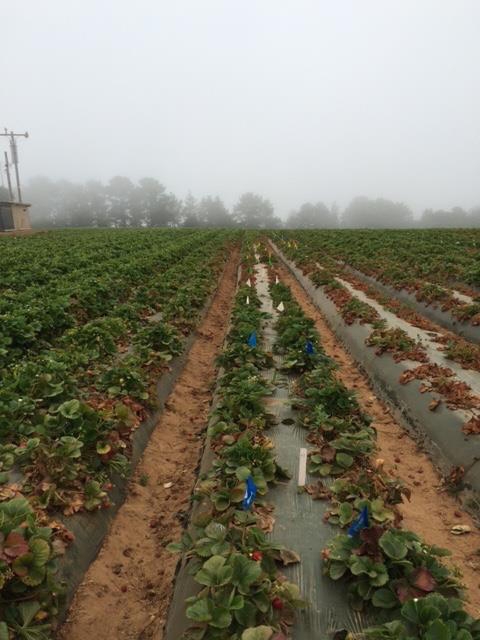
June 29, 2016. Untreated control.
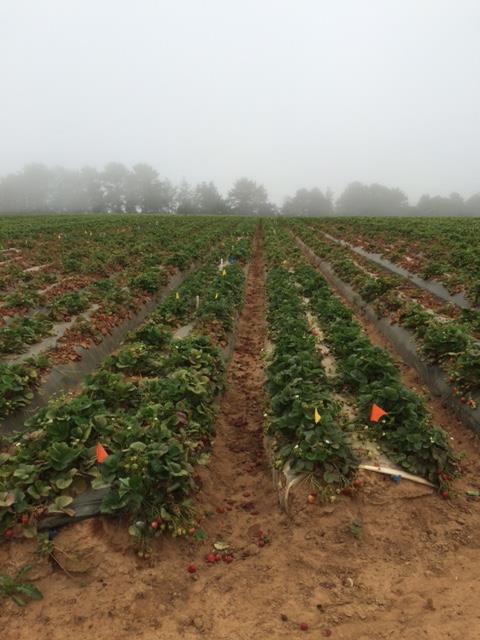
June 29, 2016. TRX treated plot.
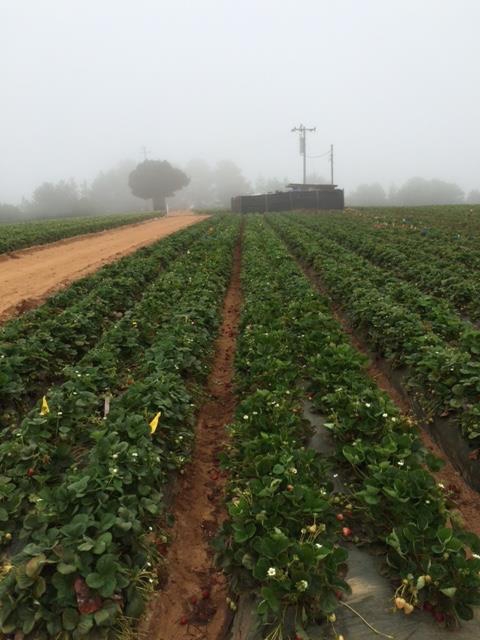
June 29, 2016. Triform 80 treated plot.

Sept 3, 2016. Monterey in untreated control.
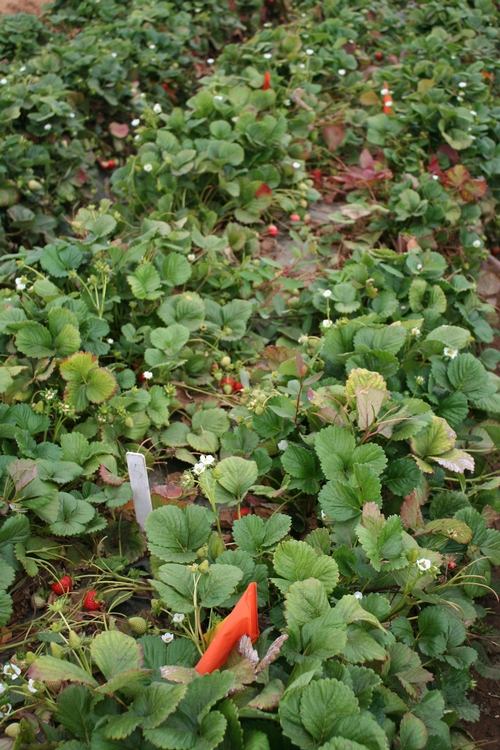
Sept 3, 2016 Monterey in Triform 80 treated plot.
I Have a Diagnosis of Macrophomina or Fusarium in My Strawberry Field – Now What Do I Do?
Accompanying the current spate of Macrophomina and Fusarium discoveries by the UCCE Diagnostic Laboratory in Salinas and by other pathologists, growers, farm managers, and PCAs are now faced with the question of what the next step should be.
Fumigation: The advice for growers and farm managers is to avoid bed fumigation at this juncture. Even beds fumigated by professional operators will have little reservoirs of surviving pathogens on the shoulders where the fumigant did not travel. Of great concern are pathogen populations surviving in the soil making up the untreated furrows. Growers who are not flat fumigating with methyl bromide + chloropicrin should consider using a high rate of chloropicrin under impermeable film. This likely will not be as good a treatment as the mix of methyl bromide + chloropicrin used in the past, but it is the next best soil treatment solution.
Reducing stress to the plants: The diseases caused by both Macrophomina and Fusarium develop earlier, more rapidly, and more severely if plants are stressed. Strawberries that are under-chilled or subject to irrigation deficits, fertility shortfalls, and/or pest issues (such as mites) can succumb fairly rapidly, while those perfectly managed can withstand disease for a longer time. Growers wanting to reduce their diseases losses from here on out will need to play a tight defensive game and address plant stress factors in a timely manner.
Not disturbing the existing bed: The in-field spread of both Macrophomina and Fusarium is mainly accomplished by tillage and other procedures that move soil around. Because neither pathogen makes airborne spores (such as those made by powdery mildew and gray mold pathogens) or swimming zoospores found in soil water (produced by Phytophthora), the spread of inoculum is only by physical movement of the soil. Presumably, beds remaining intact and in place, as they would be for second year strawberries or other system of minimal tillage, will keep the pathogen from being spread to non-infested parts of the field.
This situation has been observed locally. In 2013, a strawberry field had significant Macrophomina outbreaks in certain parts of the field. Held over for a second year, the dead areas were replanted and again developed disease in those sections; however, second year plants that were healthy in 2013 were mostly healthy in 2014. While growing second year strawberries is not being recommended, this type of situation demonstrates the key role of soil movement in disease epidemiology.
Sanitation: Sanitation is critical for limiting the spread of Macrophomina and Fusarium. Tractors, tillage equipment, and irrigation pipes moving from infested fields should be cleaned. Remember too that a strawberry field that had significant dieback two years ago and is now planted to lettuce or another crop, likely still has plenty of Fusarium or Macrophomina around. It is a good practice for all of us to pay attention to where we have been and clean up if you are coming out of an infested field.
Having the Right Attitude and Accept the Changing Reality: In this environment of new diseases and reduced to no availability of good fumigants, those able to keep open minds and adopt new practices stand the best chance to weather the storm from these new pathogens. Growers and agricultural professionals of all stripes MUST adapt to this new era. Go to meetings, keep up to date on the latest research, talk with reputable professionals and be ready to make the changes necessary to keep your crop the most productive it can possibly be.
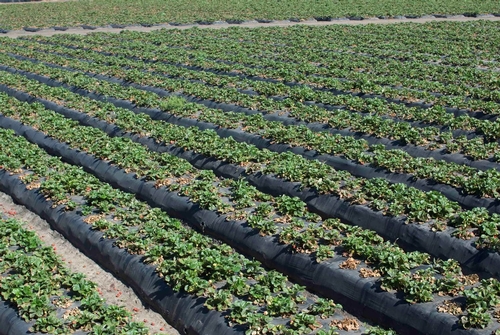
Photo progression- Field with Macrophomina June 21. Photo by Steven Koike, UCCE.
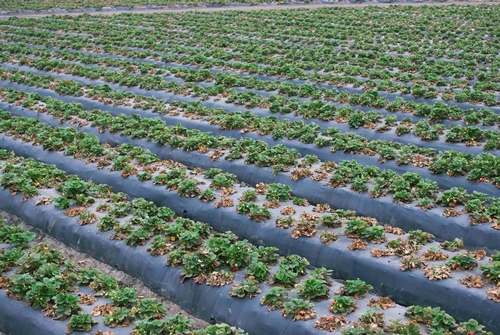
Photo progression - same field as above with Macrophomina- July 5. Photo by Steven Koike, UCCE.
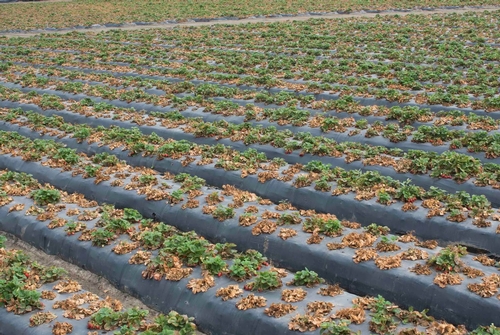
Photo progression - Same field as above with Macrophomina July 26. Photo by Steven Koike, UCCE.
Central Coast Alert: Fusarium Wilt Occurring in a Number of Strawberry Fields
2014 strawberry alert: Statewide, the California strawberry industry is grappling with two soilborne diseases that are spreading throughout the state: charcoal rot and Fusarium wilt. Both problems have been found in the Monterey-Santa Cruz region, and until recently most outbreaks were caused by the charcoal rot pathogen, Macrophomina phaseolina. However, in 2014 a number of new plant collapse cases were confirmed to be Fusarium wilt; overall, more Fusarium has been detected in 2014 than Macrophomina, a switch from previous seasons.
Symptoms: Symptoms of Fusarium wilt in strawberry consist of wilting of older foliage, plant stunting, and eventual collapse of the plant (Figures 1, 2, and 3). When plant crowns are cut open, internal vascular and cortical tissues are dark to orange brown (Figure 4). Disease is often most severe if the infected plant is subject to stresses such as weather extremes, water stress (excess or shortage of water), poor soil conditions, or heavy fruit loads. It is important to note that Fusarium wilt symptoms are virtually identical to those caused by charcoal rot.
Biology: Fusarium wilt is caused by the fungus Fusarium oxysporum f. sp. fragariae.This pathogen is host specific to strawberry and apparently can only infect this crop. The fungus survives in soil for long periods by producing resilient, microscopic structures called chlamydospores. The development of Fusarium wilt has been associated with changes in the practices of pre-plant soil fumigation. The fungus is spread within and between fields mostly by the transport of contaminated soil during soil tillage and preparation operations.
Current year management: For planted fields currently in production, there are no reliable control options for this disease. Because Fusarium wilt is more severe and develops more rapidly if strawberry plants are stressed, growers should manage the field so as to reduce stress; such steps include proper irrigation scheduling and the controlling of mites and other pests. Applying extra water will not help symptomatic plants. Even in the absence of stress, plants showing collapse symptoms eventually become non-productive.
Long term strategies: Integrated disease management strategies for subsequent crops involve the following: (1) Crop rotation. Do not plant strawberry in fields having a known history of the problem and avoid back-to-back strawberry plantings in infested locations. (2) Pre-plant fumigation. Such applications remain a useful tool for managing Fusarium and the other soilborne pests, even though most currently available fumigants are not completely effective. If fumigants are bed-applied, the level of control may be further reduced because of incomplete treatment of the soil. Measures that improve distribution of fumigants such as increasing the number of drip tapes may be beneficial. (3) Avoid stressing the plants. Stress will hasten the development and increase the severity of symptoms, so use appropriate growing and irrigation practices to reduce stress. (4) Sanitation. Growers with Fusarium infested fields need to be concerned with limiting the spread of the fungus from infested to clean fields. Being a soilborne pathogen, F. oxysporum can readily be spread by mud and dirt adhering to equipment and tires. Note that the pathogen may be resident in a field for several years before any plants show symptoms. Therefore limiting movement of soil between fields is a good practice even where no disease is evident. (5) Resistant or tolerant cultivars. UC cultivars show significant differences in susceptibility to Fusarium wilt, although none are completely resistant. San Andreas, Ventana, and Portola appear relatively resistant but reaction to the pathogen may differ year-to-year, which may be due to the variable effects of stress. Camarosa and Albion are both highly susceptible to Fusarium wilt.
Diagnosis and disease trends: Because Fusarium wilt symptoms are identical to charcoal rot symptoms and are similar to those caused by Verticillium wilt and Phytophthora root & crown rot, field diagnosis is impossible to accurately achieve. Submit strawberry collapse samples to the UC Cooperative Extension diagnostic lab in Salinas, which is supported jointly by UC and the California Strawberry Commission. Our research and extension team is closely following these disease developments; contact us if you see new outbreaks of these important problems.
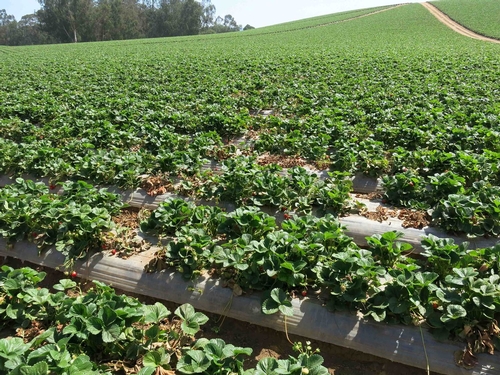
Figure 1. Weak spots in the field, consisting of collapsing plants, indicate possible problems with soilborne pathogens such as Fusarium. Photo Steven Koike, UCCE
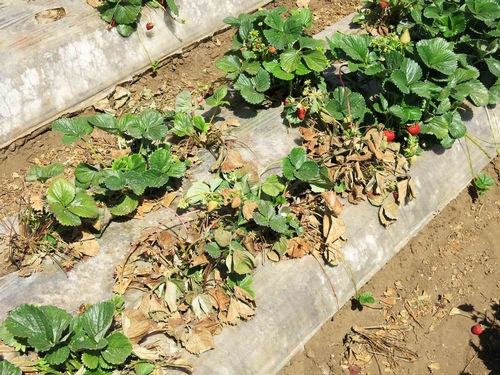
Figure 2. For plants infected with Fusarium wilt, the older leaves are the first to collapse and dry up. Photo Steven Koike, UCCE.
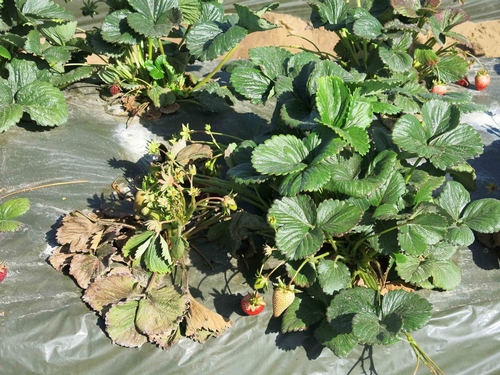
Figure 3. Strawberry plants with Fusarium wilt will eventually die. Photo Steven Koike, UCCE.
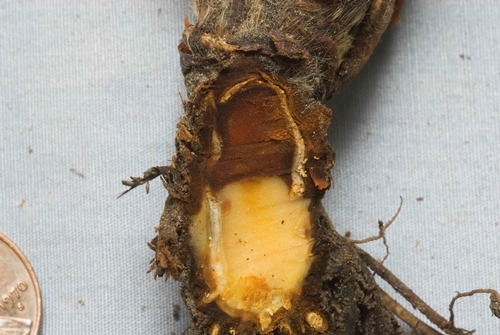
Figure 4. Internal crown tissue of strawberry infected with Fusarium will show a dark to orange brown discoloration. Photo Steven Koike, UCCE.
Fusarium wilt of strawberry: second soilborne threat in California
While the recently detected charcoal rot disease (caused by the soilborne fungus Macrophomina phaseolina) was causing collapse of strawberry plants from various parts of California, a second soilborne issue was simultaneously affecting other fields. Fusarium wilt was first confirmed on California strawberry in 2006. Initially found in Ventura County, Fusarium wilt is now present on strawberry in Santa Barbara and Monterey counties. The spread of Fusarium wilt in the state, along with the increasing problems with Macrophomina, poses long term threats to the strawberry industry which at present does not have satisfactory plant resistance to both of these pathogens and which is facing a changing future without traditional fumigant products.
Symptoms of Fusarium wilt in strawberry consist of wilting of foliage, plant stunting, and drying and death of foliage (Figure 1). When plant crowns are cut open, internal vascular and cortex tissues are dark to orange brown (Figure 2). Disease is often most severe if the infected plant is subject to stresses such as weather extremes, water stress (shortage of water), poor soil conditions, or heavy fruit loads. In locations where the disease has occurred for more than one season, the patches can be quite large and appear to have spread from the initial problem area (Figure 3). Such patterns are consistent with the spread of a soilborne pathogen. It is noteworthy that in these cases we have never isolated other important, well known pathogens such as Colletotrichum, Phytophthora, or Verticillium. However, it is important to note that Fusarium wilt symptoms are virtually identical to those caused by charcoal rot. To complicate matters further, in some fields we have found both Fusarium and Macrophomina infecting the same crop. This overlap of symptoms means that growers and field personnel should have plants tested by a pathology lab in order to confirm which soilborne disease they are encountering.
Fusarium wilt is caused by the fungus Fusarium oxysporum f. sp. fragariae. This pathogen is host specific to strawberry and can only infect this crop. The fungus survives in the soil for long periods by producing resilient, microscopic structures called chlamydospores (Figure 4). The development of Fusarium wilt has also been associated with changes in the practices of pre-plant soil fumigation. The fungus is spread within and between fields mostly by the transport of contaminated soil during soil tillage and preparation operations.
Current management strategies involve the following: (1) Crop rotation. Do not plant strawberry in fields having a known history of the problem and avoid back-to-back strawberry plantings in infested locations. (2) Pre-plant fumigation. This remains a useful tool for managing Fusarium and the other soilborne pests, even though bed-applied fumigants may not provide complete control. (3) Avoid stressing the plants. Stress will hasten the development and increase the severity of symptoms, so use appropriate growing and irrigation practices to reduce stress. Note, however, that even in the absence of stress, infected plants will eventually develop the disease. (4) Sanitation. Growers with Fusarium infested fields need to be concerned with limiting the spread of the fungus from infested to clean fields.
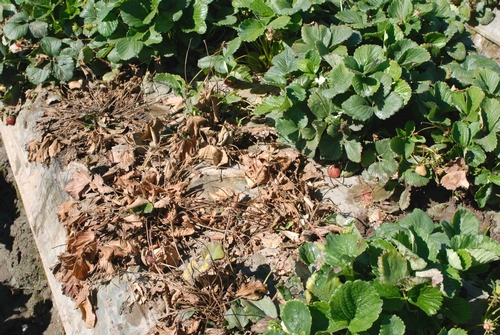
Figure 1. Fusarium results in the collapse and death of strawberry plants. Photo Steven Koike, UCCE
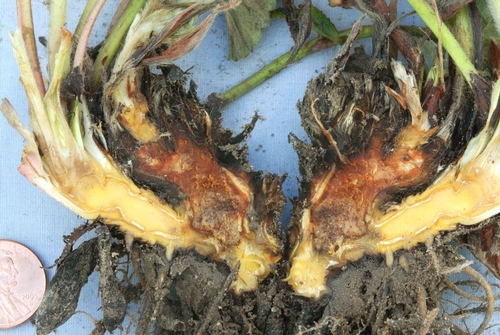
Figure 2. Internal crown tissue of strawberry infected with Fusarium will show a dark to orange brown discoloration. Photo Steven Koike, UCCE
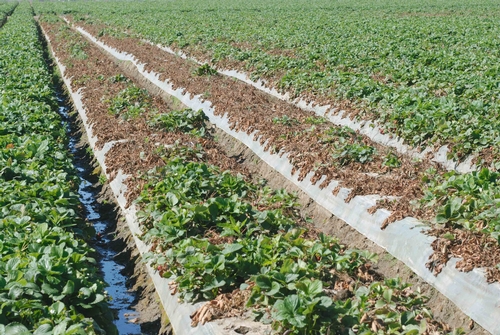
Figure 3. Fusarium wilt can affect large portions of a field and cause significant dieback. Photo Steven Koike, UCCE
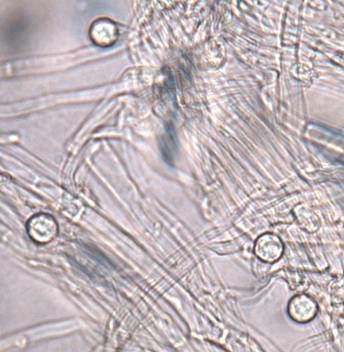
Figure 4. Microscopic structures called chlamydospores enable the Fusarium pathogen to survive in the soil. Photo Steven Koike, UCCE

